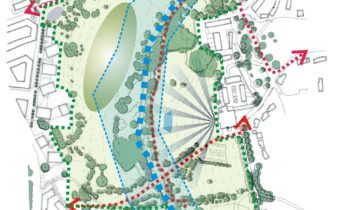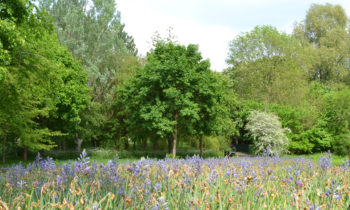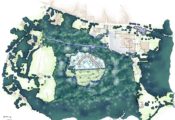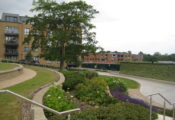St Andrews Park, Uxbridge
Client: VSM Estates, a joint venture between Vinci Construction and St Modwen Developments
INTRODUCTION
Allen Pyke have been involved with the redevelopment of the former MOD site; RAF Uxbridge – known as St Andrew’s Park for every design stage. This began with the outline planning application through to overseeing construction works on site.
The scheme was consented in 2012, and comprises of approximately 1,400 residential units, a theatre, offices, several retained buildings, a town square, green roof gardens, retail units, a school, and a new District Park.
For the original hybrid planning application, Allen Pyke worked on the Landscape and Open Space Strategy, Historical Landscape Report, Design Code and prepared the Landscape and Visual Impact Assessment (LVIA) for the Environmental Impact Assessment (EIA).
Allen Pyke has worked with multiple co-consultants over the course of the project such as master planners, urban designers, architects, ecologists, engineers (civil, highways and hydrology), planners, arboriculturists and CDM coordinators, as well as the client’s own design, planning and technical teams.
Since we are appointed by both the original developer (a joint venture between St Modwen Developments Ltd and Vinci Ltd), and by the developers of the individual residential phases (Persimmon Homes, St Modwen and St Modwen Homes), both clients benefit from our in-depth knowledge of the site, and its constraints and the development proposals.
BACKGROUND
This site was complex, and many significant constraints arose, where opportunities were to be considered.
The site contains a number of listed buildings. A direct legacy of its approximately 90 years as a military establishment within the grounds of the 18th century Grade II Hillingdon House. Allen Pyke undertook a comprehensive historic landscape survey reviewing the landscape development from the 17th and 19th centuries, and through to the various phases of the military use. This included barracks training, and a several bunkers including one which Churchill used during WWII and is now Grade I listed. The findings of the survey were subsequently used to inform the Masterplan and Landscape Strategy. Churchill’s Bunker is now a central part of the Battle of Britain Bunker Museum which opened in 2018.
Part of the site is designated as Green Belt and is bisected by the River Pinn. There are areas of mature woodland, badgers, and bats, and it is crossed by a Public Right of Way. The intention was to create a vibrant, thriving, and attractive place sitting comfortably within its context which enhances the neighbouring areas. In addition to the new 14ha District Park – one of Greater London’s largest new publicly accessible green spaces to be delivered for many years, the masterplan had to incorporate sustainable urban drainage features, play areas and public realm.
AWARDS
To ensure the redevelopment of the site was as sustainable as possible, a comprehensive SuDS strategy was developed. This included street design with a range of swales and parks incorporating basins and grassed swales.
Working closely with the project engineers, we were able to ensure that the designs remained attractive elements within the public realm, as well as providing efficient drainage solutions. In addition, we prepared a detailed management plan to ensure all elements within the scheme were adaptable to the changing nature of the development, in particular the issues associated with heavy rainfall and occasional inundation.
The scheme won the New Build Large Scale Award at the 2018 Susdrain SuDS Awards, through a nomination by LB Hillingdon.
EXAMPLES OF SPECIFIC OUTPUTS BY APAL
- Landscape and Open Space Strategy
- Illustrative Masterplan
- Landscape and Visual Impact Assessment
- Historic Landscape Survey
- Design Code
- Design and delivery of the District Park
- SuDS Strategy:
- Reserved matters and condition clearance for residential phases: General Arrangement Plans, Planting Plans, Planting Specifications, Tree Protection Plans, NBS Specification.
- Landscape Management Specifications.
- Public Consultation: prepare material for exhibition boards and attendance at public exhibitions.
- Trees: Coordination of arboriculture surveys, impact assessments and method statements.
- Liaising with Local Planning Authority
- Tendering, contract administration and site supervision.














